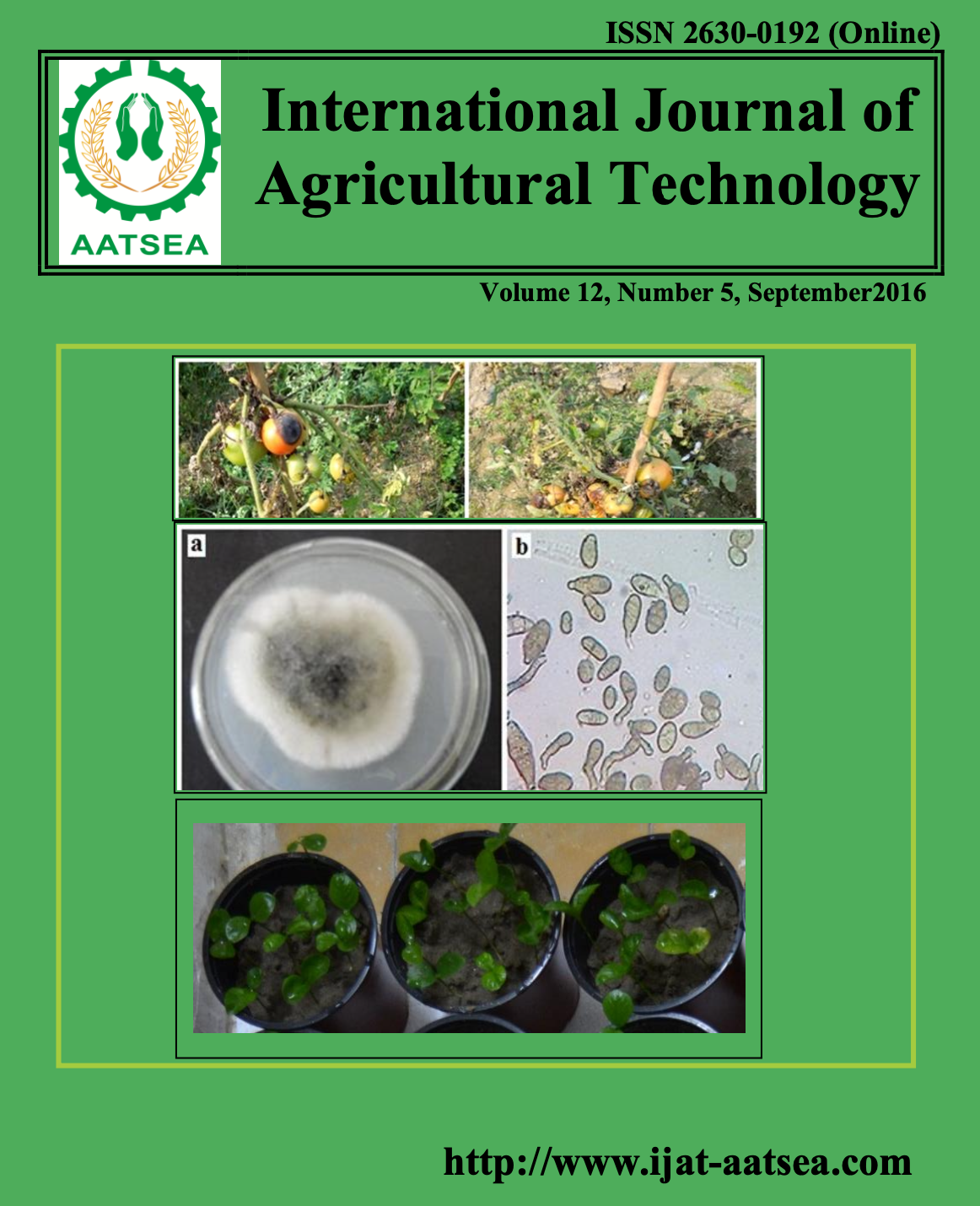Isolation and pathogenicity of the fungus, Fusarium solani a causal of dry root rot on sour orange in Baghdad province
Main Article Content
Abstract
Article Details

This work is licensed under a Creative Commons Attribution-NonCommercial-NoDerivatives 4.0 International License.
References
Abbas, A. H., Abdul-Fatah, F. A. and Moheei, M. N. (1990). The role of Fusarium solani in slow die back of citrus. Iraqi journal of life sciences 10:27-40.
Al-Hakim, A. M. H. (1975). Occurrence rootstocks reaction, and control of the Citrus Nematode. Tylenechulus semipenetrans Cobb. (Master’s thesis). University of Baghdad. 71 pp.
Al-Heeti, A. A., Mahdi, N., Hamid, B. and Mohsson, W. (1995). Autumn blight, their Causes, nature of occurrence and control. The Iraqi journal of Agriculture Sciences 26:162-174.
Baker, R. A., Tatum, J. H. and Nemec, S. (1981). Toxin production by Fusarium solani from fibrous root of blight diseased citrus. Phytopathology 71:951-954.
Bateman, D. F. and Lumsden, R. D. (1965). Relation of calcium content and nature of Pectin substances in bean hypocotyls of different ages of Rhizoctonia solani. Phytopathology 55:734-738.
Bollkan, H. H. and Butler, E. E. (1974). Studies on Heterokaryosis Virulence of Rhizoctonia solani. Phytopathology 64:513-522.
Booth, C. (1977). Fusarium Laboratory guide to the identification of the major Species. Kew, Survey, England: Commonwealth Mycological Institute. 58 pp.
Brasileiro, B. T. R. V., Coimbra, M. R. M. and Toliveria, N. (2004). Genetic variability within Fusarium solani specie's as revealed by PCR-Finger-printing based on PCR markers. Brazilian Journal of Microbiology 35:205-210.
Domsch, K. H., Games, W. and Anderson, T. (1980). Compendium of soil fungi. London: Academic Press. 858 pp.
Farr, D. C., Bills, G. F., Chamuris, G. P. and Rossman, A. Y. (1989). Fungi on plants and plant products in the United States. APS press. 1251 pp.
Hasson, I. K. (2005). Biological and chemical control to the potato stem. (Ph.D. thesis). College of Agriculture, University of Baghdad.
Jain, R. K. and Thapliyal, P. N. (1980). Toxic metabolites from Rhizoctonia solani Kuhn: production and possible role in pathogenesis. Indian Journal of Experimental Biology 18:316-318.
Juber, K. S. and Hasson, I. K. (2006 ). Evaluation the efficiency of some Inducing compound chemicals and biocontrol agents in Controlling black scurf disease of potato under greenhouse and field conditions, The Iraqi Journal of Agricultural Sciences.
Juber, K. S. and Kuthair, W. M. (2009). The relation between Fusarium solani casual of citrus root rot toxins and its pathogenicity. The journal of Agricultural Sciences 40:63-77.
Kamel, M., Shatta, M. N. and Shanawanai, M. Z. (1973). Histopathological studies on the hypocotyls of lentils infected by Fusarium solani. Z. Pflanzenkr. Pflanzenschutz 80:547-550.
Khosrow, C., Salleh, B. and Zakaria, L. (2015). Morphological and Phylogenetic Analysis of Fusarium solani Species Complex in Malaysia. Microbial Ecology 69:457-471.
Kumar, S., Thind, T. S. and Chander, M. (1995). Morphogenic and pathogenic variations in Gloeosporium ampelogphagum. Indian Phytopathology 48:331-334.
Kunta, B., Salas, M. G. and da Graca, J. V. (2015). First report of citrus dry root rot caused by Fusarium solani on sour orange rootstock in Texas Journal of Citrus Pathology. Journal of Cutaneous Pathology.
Kuthair, W. M. (2007). Integrated control for citrus, root rot disease caused by Fusarium solani. Ph.D. Dissertations College of Agriculture, University of Baghdad. 119 pp.
Lozovaya, V. V., Lygin, A. V., Zernova, O. V., Li, S., Widholm, J. M. and Hartman, G. L. (2006). Lignin degradation by Fusarium solani f.s. glycines. Plant Disease Journal 9:77-82.
Mohammad, H. Y., Husain, S. I. and Al-Zarai, A. J. (1981). Nematode found and Fungi flora associated with Citrus aurantium L. at seven different orchards of Nineveh and Diyala provinces of Iraq. Mesopotamia Journal of Agriculture 16:185- 205.
Nalim, F. A, Samuels, G. J., Wijesundera, R. L. and Geiser, D. M. (2011). New species From the Fusarium solani species complex derived from perithecia and soil in the Old World tropics. Mycologia 103:1302-1330.
Nelson, P. E. Toussoun, T. A. and Marasas, W. F. O. (1983). Fusarium species : An Illustrated Manual for Identification. University Park: Pennsylvania State University Press. 193 pp.
Nelson, B. D. and Hansen, J. M. (1997). Reaction of soybean cultivars to isolates of Fusarium solani from the red river valley. Plant Disease Journal 81:664-668.
Nemec, S., Jabaji–Hair, S. and Charest, P. M. (1991). ELISA and immunological detection of Fusarium solani produced napthazariin toxin in citrus tree in Florida. Phytopathology 81:1497-1503.
Nemec, S. (1995). Stress related compound in Xylem fluid of blight diseased citrus containing Fusarium solani naphthazarin toxins and their effect on the host. Canadian Journal of Microbiology 41:515-524.
Obaid, Q. M. (2014). Effectiveness of some biological agents to resist Rhizoctonia solani Kṻhn the cauliflower stem canker pathogen. (Master’s thesis). Department of plant protection, College of Agriculture. 102 pp.
O Connell, N. (2006). Dry root rot in citrus. University of California Cooperative Extension Tulare County. 9 pp.
Olsen, M., Matheron, M., McClure, M. and Xiong, Z. (2000). Disease of 29 Citrus in Arizona. Extension, University of Arizona: Plant disease publications cooperative. 15 pp.
Pannecoucque, J. and Hofte, M. (2009). Interactions between cauliflower and Rhizoconia anastomosis groups with different levels of aggressiveness. BMC Plant Biology 9:95.
Ravi, M. C. and Kumar, M. R. (2012). Studies on cultural, morphological variability in isolates of Fusarium solani (Mart.) Sacc., incitant of dry root- rot of Citrus. Current Biotica 6:152-162.
Salam, A. H. (2009). Determination of variance resource and mechanism of pathogenicity for some Beauveria bassiana isolates and evaluation their efficiency in control corn stem borer Sesamia certica under field condition. (Ph. D. thesis). Department of Plant Protection, College of Agriculture, University of Baghdad.
SAS (2012). Statistical Analysis System, User's Guide. Statistical Version 9.1th edition. USA.: SAS. Inst. Inc. Cary. N. C.
Sherbakoff, C. D. (1953). Fusarium associated with citrus feeder roots in Florida. Phytopathology 43:395-397.
Tatum, J. H, and Baker, R. A. (1983). Naphthoquinones produced by Fusarium solani Isolated from citrus. Phytochemistry 22:543-547.


